Explore Daejeon - South Korea Travel, Asia
Daejeon, located in west-central South Korea, is a bustling metropolitan city known for its strategic position and rich culture. Nestled in a lowland valley between the Sobaek Mountains and the Geum River, it's about 170 kilometers (106 miles) south of Seoul and serves as a key transportation hub, connecting major cities by rail and road.
With a population of approximately 1.47 million as of 2023, Daejeon is the fifth-largest city in South Korea. It's renowned as a science and technology hub, often called the "Silicon Valley of Korea." The city is home to major research institutions like KAIST and Chungnam National University, as well as Daedeok Science Town, a center for innovation and research.
Population: Approximately 1.5 million people.
Economy: Daejeon has a robust economy characterized by its focus on science, technology, and research. It is home to the Daedeok Innopolis, a major research and development hub that houses numerous government-funded and corporate research institutes, as well as small and medium-sized enterprises in advanced fields such as biotechnology, information technology, and materials science. The city serves as a center for administrative functions, hosting various government agencies, which contributes to its economic stability. Daejeon is also known for its manufacturing sector, producing textiles, machinery, and chemicals.
Attractions: Expo Park, Hanbat Arboretum, Daejeon O-World, Daecheong Lake, Yuseong Hot Springs
South Korea
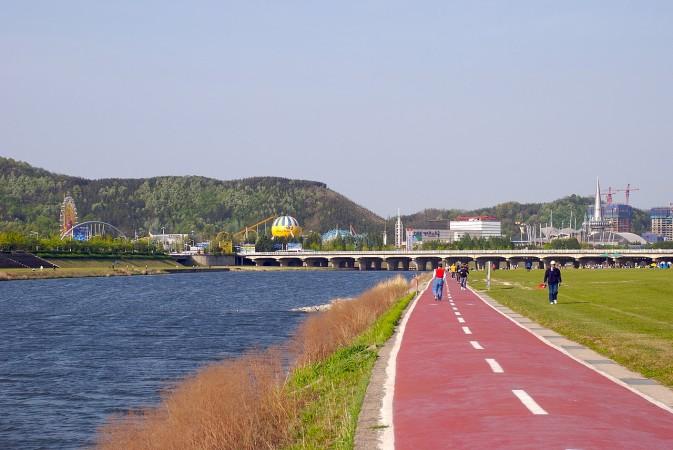
Overview of Daejeon
History & Cultural Influence
Historically known as "Hanbat," meaning "large field" in Korean, Daejeon was a small village during the Joseon Dynasty. The city's transformation began in the early 20th century with the development of railway lines under Japanese rule. The completion of the Gyeongbu Railway in 1905 and the Honam Railway in 1926 turned Daejeon into a major transportation hub, facilitating rapid growth and modernization.
During the Japanese colonial period, Daejeon experienced significant cultural influence from Japanese settlers, who constituted a large portion of the population. This era left a lasting impact on the city's cultural landscape, as seen in certain local dialects and traditions.
Interaction with The Locals
Daejeon's cultural identity is deeply intertwined with its role as a center for science and technology. The establishment of Daedeok Innopolis, a major research and development district, has attracted numerous scientific institutions and high-tech businesses, earning the city the nickname "Asia's Silicon Valley." This focus on innovation and research has fostered a culture of academic excellence and technological advancement.
The city is also known for its natural beauty, with numerous parks, rivers, and hot springs that reflect the residents' fondness for nature. Cultural events such as the Daejeon Science Festival and various local fairs celebrate the city's scientific achievements and cultural heritage, drawing visitors from around the country.
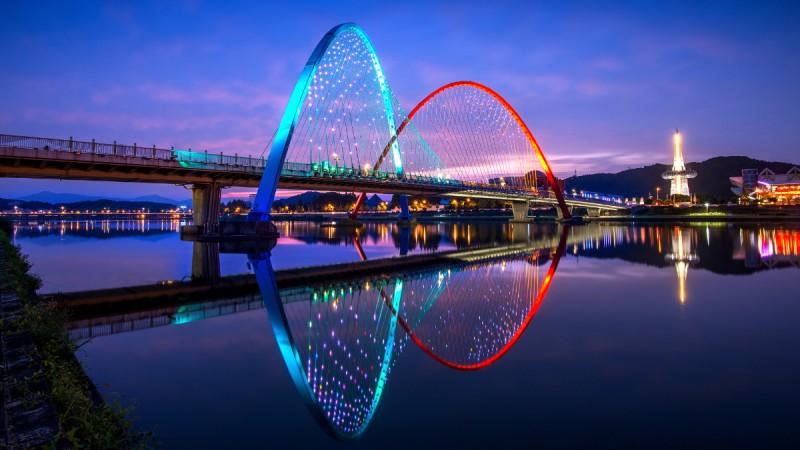
Daejeon - © southofseoul
Top Attractions in Daejeon
Daejeon, offers a variety of attractions that cater to different interests. From beautiful botanical garden showcasing diverse species, to a unique hiking experience with its soft red clay paths and stunning views from Gyejoksan Fortress. These attractions highlight Daejeon's blend of natural beauty and cultural experiences, making it a compelling place to explore.
Expo Science Park
Location: 70, Daedeokdae-ro, Yuseong-gu, Daejeon, South Korea
Built following the 1993 Daejeon Expo, Expo Science Park is a must-visit for science and education enthusiasts. The park is home to notable landmarks such as the Hanbit Tower, simulation theaters, and the Daejeon Expo Memorial Hall. It offers interactive exhibits that explore scientific concepts in an engaging way, making it a perfect spot for families and anyone looking to learn while having fun.
Hanbat Arboretum
Location: 169, Dunsan-daero, Seo-gu, Daejeon, South Korea
As one of Korea’s largest urban arboretums, Hanbat Arboretum is a peaceful escape within the city. This beautifully designed space features a wide variety of plant species spread across themed gardens. It's an ideal spot for a relaxing walk, a family day out, or simply enjoying the beauty of nature. The arboretum is also a popular destination for photography and picnics, offering tranquility in the heart of Daejeon.
Daecheong Lake
Location: Near Daejeon, South Korea
Daecheong Lake is a stunning artificial lake known for its scenic landscapes and recreational opportunities. Visitors can enjoy activities like boating, fishing, and hiking along the lake’s shores. The area is perfect for a peaceful picnic or just soaking in the natural beauty. With its serene setting, Daecheong Lake is a great escape from the city for those seeking outdoor leisure.
Yuseong Hot Springs
Location: 574, Bongmyeong-dong, Yuseong-gu, Daejeon, South Korea
The historic Yuseong Hot Springs is famous for its natural therapeutic waters. Known for their healing properties, these mineral baths have been a go-to relaxation spot for locals and visitors alike. Whether you're looking to soothe tired muscles or simply unwind, Yuseong Hot Springs offers a rejuvenating experience in a calm and peaceful setting.
Gyejoksan Mountain
Location: Near Daejeon, South Korea
Gyejoksan Mountain is well-known for its picturesque hiking trails and unique barefoot walking path. Outdoor enthusiasts can explore the mountain while enjoying breathtaking views of Daejeon and its surrounding landscapes. The barefoot trail, in particular, offers a one-of-a-kind experience as you connect with nature in a more intimate way. Gyejoksan is the perfect destination for hikers seeking both adventure and relaxation.
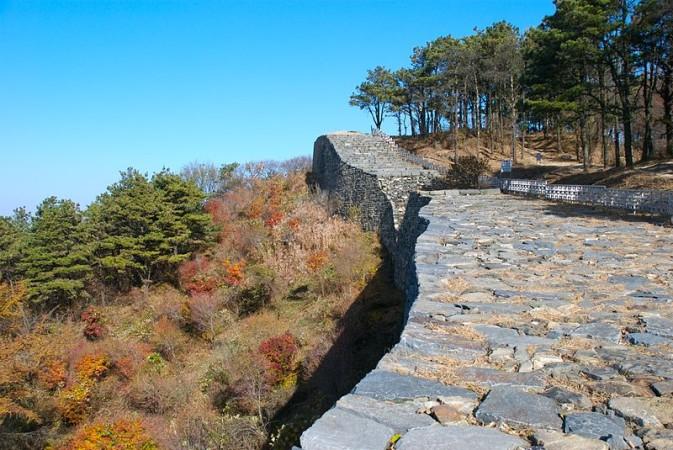
Gyejoksan Mountain - © Wikipedia
Must-Try Dishes in Daejeon
Daejeon boasts a rich culinary scene with several must-try dishes that reflect its local flavors. From a popular handmade noodle dish served in a savory broth made with ground beef, to a nutritious dish with fresh vegetables and a spicy soy sauce, perfect for a light yet satisfying meal. These dishes highlight Daejeon's unique culinary heritage and are essential experiences for any visitor to the city.
- Garak-Guksu (Handmade Noodles): Garak-Guksu is a traditional noodle dish made with handmade wheat noodles served in a savory broth, often accompanied by vegetables and beef. This dish showcases the region's emphasis on fresh ingredients and is a comforting staple for locals, especially during colder months.
- Samgyetang (Ginseng Chicken Soup): A nourishing soup featuring a whole chicken stuffed with glutinous rice, ginseng, and jujubes, simmered to create a rich broth. Samgyetang is particularly popular during the summer months, believed to provide stamina and health benefits, making it a cultural favorite.
- Tteokbokki (Spicy Rice Cakes): Tteokbokki consists of chewy rice cakes stir-fried in a spicy and slightly sweet sauce, often garnished with fish cakes and green onions. This beloved street food is a must-try for visitors, reflecting Daejeon's vibrant street food culture and is often enjoyed as a quick snack or meal.
- Kimchi Jjigae (Kimchi Stew): A hearty stew made with fermented kimchi, tofu, pork, and various vegetables, simmered to enhance the flavors. Kimchi jjigae is a staple in Korean households and represents the importance of kimchi in Korean cuisine, making it a comforting dish for locals.
- Bulgogi (Marinated Beef): Bulgogi features thinly sliced beef marinated in a mixture of soy sauce, sugar, sesame oil, and garlic, then grilled or stir-fried. This dish is celebrated for its sweet and savory flavors and is often served at special occasions, highlighting the region's culinary heritage.
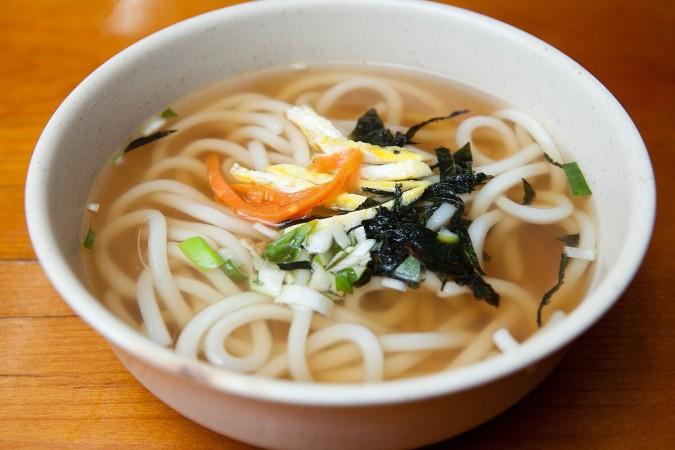
Garak-Guksu - © Wikimedia
Weather in Daejeon: Best Time to Visit
Daejeon experiences a humid continental climate, characterized by distinct seasons with hot summers and cold winters. Here’s an overview of the weather and climate in Daejeon, including average temperatures, rainfall, the best time to travel, and other relevant weather patterns.
Average Temperatures
Winter (December to February)
- Average highs range from 1°C to 6°C (34°F to 43°F), with January being the coldest month, averaging around -5°C (23°F).
- Average lows can drop to -6°C (21°F) in January.
Summer (June to August)
- Average highs range from 28°C to 31°C (82°F to 88°F), with August being the warmest month at around 31°C (88°F).
- Average lows during this period are around 22°C (72°F).
Rainfall
- Annual Precipitation: Daejeon receives approximately 126 mm (4.97 inches) of rainfall annually, with about 119 rainy days throughout the year.
- Wettest Month: July is the wettest month, averaging around 311 mm (12.24 inches) of rain, while January is typically the driest month with about 17 mm (0.67 inches).
Best Time to Travel
- Spring (April to June) and Fall (September to November): These seasons are considered the best times to visit Daejeon, as the weather is mild and pleasant, with blooming flowers in spring and beautiful foliage in fall.
- Summer (July to August): While summer can be hot and humid, it is also a vibrant time for festivals and outdoor activities. Travelers should be prepared for occasional heavy rainfall.
- Winter (December to February): Winters can be cold and snowy, making it less ideal for outdoor activities but suitable for those interested in winter sports or enjoying the winter scenery.
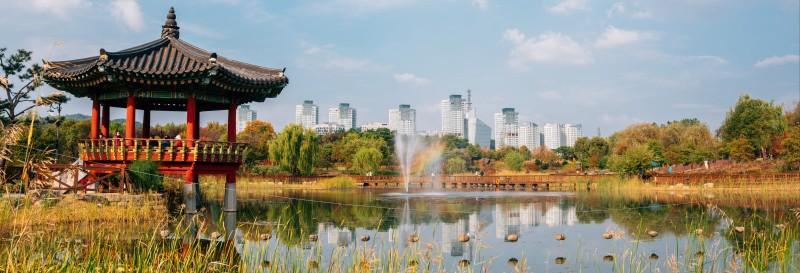
Hanbat Arboretum - © EnVols
Shopping in Daejeon
- Daejeon Jungang Market: Jungang Market is one of the largest, offering everything from fresh produce and seafood to clothing and household goods. Walking through the bustling market, you can immerse yourself in local life while sampling street food and discover locally made items such as traditional crafts, textiles, and pottery.
- Eunhaeng-dong Shopping Street: Eunhaeng-dong is a vibrant area known for its trendy clothing stores, cafes, and beauty shops. It’s a popular spot for both locals and visitors, particularly among younger shoppers looking for the latest fashion trends.
- Underground Shopping Centers at Daejeon Station: Daejeon’s underground shopping centers are a convenient option for those looking to shop on a budget. It’s a great place to browse for deals, especially if you’re looking for trendy, yet inexpensive clothing and accessories.
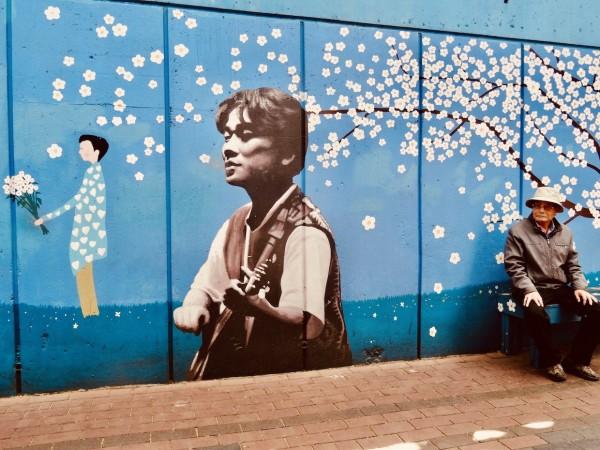
Kim Kwang-seok Memorial Street, Daegu - © Leighton Travels!
Festivals & Local Celebrations
Daejeon Science Festival
- Time of Year: Typically held in October
- Every October, Daejeon transforms into a playground for curious minds during the Daejeon Science Festival. The event takes place in the heart of Korea’s tech hub, offering interactive activities and showcases of cutting-edge technology. It’s an especially exciting experience for families and kids, with hands-on exhibits that encourage creativity and learning. The festival also blends science with elements of literature, making it both educational and fun for all ages.
Zero O'Clock Festival
- Time of Year: August
- The Zero O'Clock Festival brings Daejeon to life every August with a vibrant mix of cultural performances, entertainment, and community activities. The festival has become a beloved tradition, with locals and visitors coming together to enjoy live music, dance, and creative displays that reflect the energetic spirit of the city. It’s a perfect way to experience Daejeon’s lively atmosphere and connect with its vibrant cultural scene.
Daecheongho Daedeok Music Festival
- Time of Year: 2024 (dates vary)
- Set against the stunning backdrop of Daecheong Lake, the Daecheongho Daedeok Music Festival is a must for music lovers. With a lineup that includes both international and local Korean artists, the festival offers a diverse musical experience surrounded by natural beauty. In addition to the music, attendees can explore traditional Korean performances, engage in workshops, and indulge in local food. The festival also emphasizes sustainability, making it a meaningful celebration of both culture and nature.
DICU Festival (Daejeon Intermedia Comics Union Festival)
- Time of Year: Held twice a year, in February and August
- For fans of comics and animation, the DICU Festival is a highlight of Daejeon’s cultural calendar. This festival celebrates the world of cartoons and animation with events like custom play shows, dance contests, musicals, and animation song performances. Supported by the Daejeon Information & Culture Industry Promotion Agency, it’s a lively and creative space where fans of all ages can dive into the world of animated storytelling and entertainment.
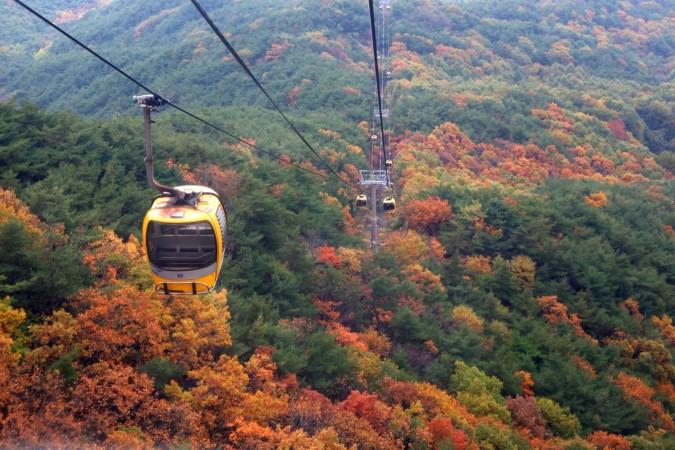
Palgong Mountain - © 4h.com.vn
Culture Etiquette in Daejeon
When visiting Daejeon, it's important to be aware of some key cultural etiquette and customs to ensure respectful interactions with locals:
Greetings
- Bowing is a common greeting in Korea, with the depth of the bow indicating the level of respect. A slight bow is sufficient for casual encounters, while a deeper bow is appropriate for more formal situations or when greeting elders.
- Handshakes are also common, especially in business settings. Use both hands when shaking hands with someone older or of higher status to show respect.
Dining Etiquette
Wait for the eldest person at the table to start eating before you begin.
- Express gratitude before and after meals by saying "잘 먹겠습니다" (I will eat well) and "잘 먹었습니다" (I ate well).
- Use both hands when passing food or drinks to others.
- Avoid sticking your chopsticks straight up in rice, as this resembles a funeral ritual and is considered offensive.
Behavior in Public
- Koreans value modesty and restraint in public. Avoid loud conversations, public displays of affection, and overly casual dress, especially in traditional areas.
- Don't interrupt others when they are speaking, as the most important parts of the message are often at the end of the sentence in Korean.
- Avoid sitting in priority seats on public transportation unless you are elderly, disabled, or traveling with small children.
Gift-Giving
- If invited to someone's home, bringing a small gift is customary. Use both hands to present and receive gifts.
- Avoid giving white flowers or gifts written in red ink, as these are associated with funerals and carry negative connotations.

Zero O'Clock Festival - © Nine O' Clock
Essential Travel Information
Getting Around Daejeon
- Buses: Daejeon has an extensive public bus network that connects various parts of the city, making it easy to reach attractions and neighborhoods.
- Taxis: Taxis are widely available and can be hailed on the street or booked via phone. They are a convenient option for short distances or when traveling with luggage.
- Ride-Sharing Services: Apps like KakaoTaxi are available in Daejeon, allowing visitors to request rides conveniently through their smartphones.
- Bicycles and Walking: Daejeon is bike-friendly, with several bike rental services available. Walking is also a pleasant way to explore the city, especially in areas with parks and cultural sites.
ATM & Banking Services
ATMs are widely available throughout Daejeon, including in subway stations, shopping centers, and bank branches. Many ATMs in South Korea are multifunctional, allowing users to withdraw cash, pay bills, and deposit money.
For international visitors, it's important to look for ATMs marked with "Global Services" or "Global ATM" and displaying Visa or Mastercard logos, as not all ATMs accept foreign cards. If one ATM does not work, trying another is recommended, as different banks may accept different card types.
Where to Stay in Daejeon
- Lotte City Hotel Daejeon: A modern hotel offering comfortable rooms and amenities, suitable for both business and leisure travelers. It is conveniently located near the Daejeon Convention Center.
- Hotel Interciti: Known for its excellent service and facilities, this hotel provides a luxurious stay with features such as a fitness center and on-site dining options.
- Good Morning Residence Hue: A budget-friendly option offering clean and comfortable accommodations with convenient access to public transportation and local attractions.
- Daejeon I-Hotel: Offers affordable lodging with essential amenities, ideal for travelers looking for a simple and economical stay.
Palgong Mountain - © gather
Articles for you

Explore Yala National Park - Sri Lanka Travel, Asia
Tucked away in Sri Lanka’s southeastern corner, Yala National Park is where wild nature meets deep tradition. Known worldwide for its leopard population, the park is also home to elephants, sloth bears, crocodiles, and hundreds of bird species. Beyond wildlife, Yala opens doors to a cultural landscape dotted with ancient temples, Buddhist ruins, and coastal villages. For travelers seeking more than just a safari, Yala offers a chance to explore eco-tourism, local communities, and sacred heritage sites.
Population: The Yala National Park area doesn’t have a human population.
Economy: The economy around Yala National Park thrives on a blend of eco-tourism, agriculture, and local services. Safari tours, eco-lodges, and cultural experiences drive steady income for nearby towns like Tissamaharama and Kataragama, supporting thousands of families.
Landmarks: Famous for Block I of Yala and wildlife encounters, including elephants, sloth bears, crocodiles, and exotic bird species.

Explore Galle - Sri Lanka Travel, Asia
Nestled on Sri Lanka’s southern coastline, Galle is a vibrant city where history meets the sea. Its cobbled streets, colonial architecture, and serene beaches make it a must-visit destination for travelers seeking a blend of culture, adventure, and relaxation. A UNESCO World Heritage site, Galle captivates visitors with its Dutch Fort, bustling markets, and friendly locals. Whether you’re exploring the ramparts at sunset or savoring fresh seafood by the shore, Galle promises an unforgettable journey into Sri Lanka’s heritage.
Population: Approximately 113,000 in 2023.
Economy: Galle’s economy thrives on tourism, trade, and fisheries. The city’s historic fort, colonial architecture, and coastal charm draw thousands of international visitors each year, making tourism its main economic driver. Fishing remains vital for local livelihoods, supplying fresh seafood across the region.
Landmarks: Famous for the Galle Fort, Dutch Reformed Church & Maritime Museum, and Unawatuna Beach.

Explore Bentota - Sri Lanka Travel, Asia
Nestled along Sri Lanka’s southwestern coast, Bentota is a tropical paradise that blends golden beaches, vibrant culture, and thrilling adventures. Famous for its calm waters, luxury resorts, and scenic river estuary, Bentota has become a top destination for travelers seeking both relaxation and authentic experiences. From serene beach walks at sunrise to adrenaline-pumping water sports, this coastal town offers a perfect balance of leisure and exploration. With its proximity to Colombo and Galle, Bentota is easy to reach, making it an ideal stop for both short escapes and extended holidays.
Population: Approximately 37,000 in 2023.
Economy: Bentota’s economy thrives mainly on tourism, which drives local businesses such as hotels, restaurants, and wellness retreats. The town also benefits from fishing, coconut cultivation, and handicrafts like wood carving and batik textiles. Many residents rely on the growing demand for water sports and Ayurvedic treatments, making tourism the backbone of both income and employment in the area.
Landmarks: Famous for Bentota Beach, Bentota River Safari, and Kande Vihara Temple.

Explore Mirissa - Sri Lanka Travel, Asia
Mirissa is a charming coastal town on Sri Lanka’s southern shoreline. Known for its golden beaches, turquoise waters, and vibrant marine life, it has become a must-visit stop for travelers exploring the island. Many come for whale watching, surfing, and sunset views at Coconut Tree Hill, but Mirissa offers much more than postcard beauty. The fishing boats you see anchored by the bay carry generations of stories. Local traditions, delicious cuisine, and a laid-back rhythm of life shape every visitor’s experience.
Population: Approximately 4,700 in 2023.
Economy: Mirissa’s economy is largely shaped by its coastal location. Fishing has long been the backbone of local livelihoods, with generations relying on the Indian Ocean for income. In recent decades, tourism has become the main driver of growth, thanks to whale watching, surfing, and beachside hospitality.
Landmarks: Famous for Mirissa Beach, Coconut Tree Hill, and Parrot Rock Bridge.

Explore Nuwara Eliya - Sri Lanka Travel, Asia
Tucked away in the Central Highlands of Sri Lanka, Nuwara Eliya is often called “Little England”. With its rolling tea plantations, cool misty mornings, and colonial charm, this mountain town feels like a step into another world. Travelers come here to breathe fresh air, walk through flower gardens, sip the finest Ceylon Tea, and enjoy a pace of life far from the island’s busy cities. Whether you’re drawn by scenic landscapes, heritage architecture, or the warmth of its people, Nuwara Eliya is a destination that blends nature, culture, and history in perfect harmony.
Population: Approximately 781,000 in 2023.
Economy: Nuwara Eliya’s economy thrives mainly on tea production, as it sits in the heart of Sri Lanka’s central highlands, famous worldwide for Ceylon Tea. The city also benefits from a growing tourism industry, attracting visitors with its colonial charm, cool climate, and scenic landscapes.
Landmarks: Famous for Gregory Lake, Hakgala Botanical Garden, and Victoria Park.

Explore Sukau - Malaysia Travel, Asia
Nestled on the banks of the Kinabatangan River in Sabah, Malaysian Borneo, Sukau is a destination where wildlife, culture, and conservation come together. Known as one of Asia’s top spots for river safaris and eco-tourism, this quiet village offers a front-row seat to encounters with Bornean orangutans, pygmy elephants, proboscis monkeys, and exotic birdlife.
Population: Approximately 1,400 in 2019.
Economy: Sukau’s economy is shaped by its riverine location and natural resources. Traditionally, the Orang Sungai community relied on fishing, small-scale farming, and forest gathering for their livelihood. Today, the village has shifted toward eco-tourism, with river cruises, jungle trekking, and homestays providing income.
Landmarks: Famous for the Kinabatangan River cruises, Gomantong Caves, and Ox-bow lakes and wetlands.
